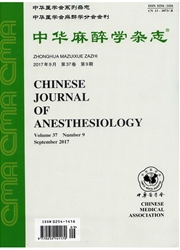

 中文摘要:
中文摘要:
目的评价不同的麻醉方式对全身麻醉下行扁桃体、腺样体切除术患儿术后行为改变的影响。方法将90例全身麻醉下行扁桃体、腺样体切除术患儿采用随机数字表法分为3组(每组30例):吸入麻醉组(s组)、全凭静脉组(P组)、静吸复合组(sP组)。根据术后行为量表(post hospitalization behavior questionnaire, PHBQ),在术后1、3、7、15d及3个月评估3组患儿消极术后行为改变(negative postoperative behavioural changes, NPOBCs)的发生。结果与S组比较,SP组术后7、15d发生NPOBCs的患儿(18例、10例)及3个月来平均每例患儿NPOBCs发生的总次数[(11±8)次]均较低,差异有统计学意义(P〈O.05);P组术后3、7、15d发生NPOBCs的患儿数(20例、16例及8例)及3个月来平均每例患儿NPOBCs发生的总次数[(6±6)次]也均较低,差异有统计学意义(P〈0.05);与sP组比较,P组患儿术后NPOBCs发生率差异无统计学意义(P〉0.05),但平均每例患儿NPOBCs发生的总次数明显较少,差异有统计学意义(P〈0.05)。结论相比吸入麻醉和静吸复合麻醉,全凭静脉麻醉可减少小儿患者NPOBCs的发生。
 英文摘要:
英文摘要:
Objective To evaluate the effects of different types of anaesthesia on postoperative behavioural changes following adenotonsillectomy under general anesthesia (GA) in children. Methods Ninety children undergoing adenotonsillectomy under GA were randomly divided into 3 groups (n=30): inhalational anesthesia group (group S), Combined intravenous-inhalational anesthesia group(group SP), total intravenous anaesthesia group(group P). According to post hospitalization behavior questionnaire (PHBQ), the incidence of negative postoperative behavioural changes (NPOBCs) was evaluated on postoperative days (POD) 1, 3, 7, 15, and 3 months after surgery. Results Compared with group S, the incidence of NPOBCs on POD 7 and 15 (18 and 10) and the overall number of NPOBCs of each child (11±8) in group SP were both lower(P〈0.05), the incidence of NPOBCs on POD 3, 7 and 15(20, 16 and 8) and the overall number of NPOBCs of each child (6+6) in group P were also significantly lower(P〈0.05), compared with group SP, there was no significant differences in incidence of NPOBCs, but overall number of NPOBCs of each child in group P was fewer (P〈0.05). Conclusions Compared with inhalational anesthesia and combined intravenous-inhalational anesthesia, total intravenous anesthesia reduce the incidence of NPOBCs in children.
 同期刊论文项目
同期刊论文项目
 同项目期刊论文
同项目期刊论文
 Inhibition of the Rho/Rhokinase pathway preventslipopolysaccharide-inducedhyperalgesia and the relea
Inhibition of the Rho/Rhokinase pathway preventslipopolysaccharide-inducedhyperalgesia and the relea Safety and Efficacy of Dexmedetomidine as a Sedative Agentfor Performing Awake Intubation: A Meta-an
Safety and Efficacy of Dexmedetomidine as a Sedative Agentfor Performing Awake Intubation: A Meta-an Network Meta-Analysis on the Efficacy of Dexmedetomidine, Midazolam, Ketamine, Propofol, and Fentany
Network Meta-Analysis on the Efficacy of Dexmedetomidine, Midazolam, Ketamine, Propofol, and Fentany Preconditioning of physiological cyclic stretch attenuated HMGB 1 expression in pathologically mecha
Preconditioning of physiological cyclic stretch attenuated HMGB 1 expression in pathologically mecha Low tidal volume ventilation preconditioning ameliorates lipopolysaccharide-induced acute lung injur
Low tidal volume ventilation preconditioning ameliorates lipopolysaccharide-induced acute lung injur 期刊信息
期刊信息
